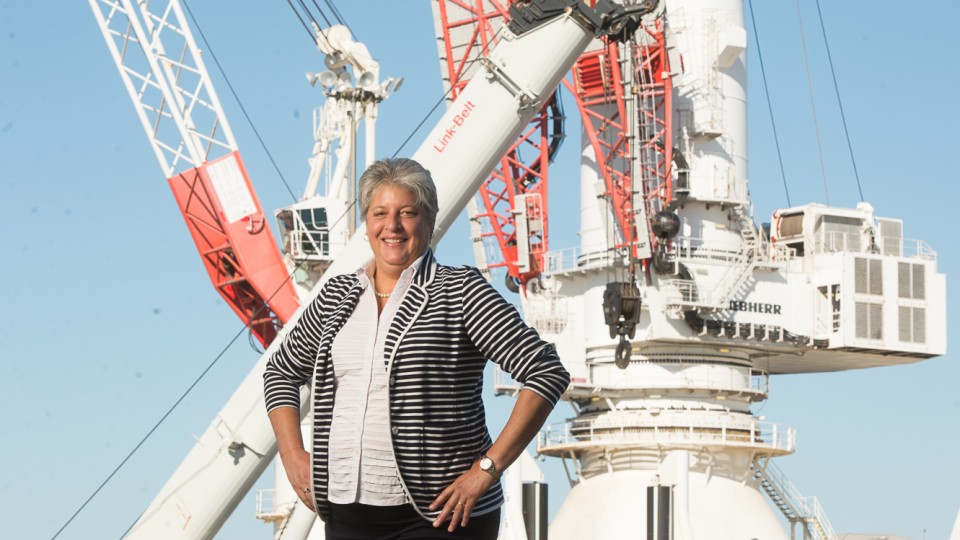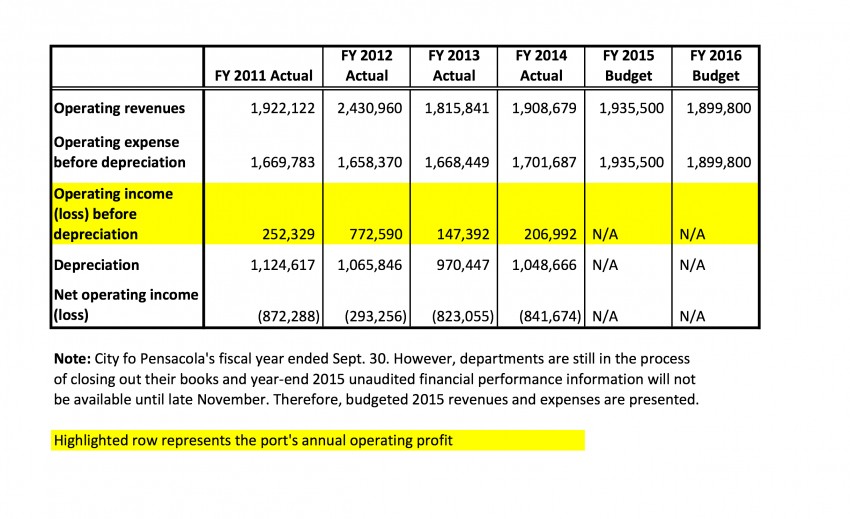Looking ahead to Port of Pensacola's future
- October 21, 2015
- / Carlton Proctor
- / economy

Amy Miller director of the Port of Pensacola Wednesday, October 14, 2015. (Michael Spooneybarger/ Studer Community Institute)
Nearing the start of her third year as director of the Port of Pensacola, Amy Miller is hoping 2016 will bring smoother sailing and calmer seas than 2015 saw.
Miller's fiscal 2015 got off with a bang as construction started on the $50 million DeepFlex subsea, petroleum pipe manufacturing facility on port property.
Construction proceeded apace until March of this year when work on the plant, the largest capital project in the port's history, came to an abrupt halt.
DeepFlex, a company based in Brazil, ran out of money and investors as the price oil marked a steep decline.
Since then the Brazilian-based company has been looking for new backers to revive the project, but so far no restart date has been announced by DeepFlex or Mobile, Ala.,-based Offshore Inland.
Offshore Inland is the company under contract to operate the manufacturing plant once it goes on line.
Despite this major setback, Miller, one of the few women in the U.S. to head a port operation, is cautiously optimistic the project will get back on track.
Miller spoke with the Studer Community Institute about the past year at the port and the opportunities she sees ahead.
Question: Financially, how did the Port of Pensacola end fiscal year 2015?
Answer: Fiscal year ended Sept. 30, and we are paying bills for fiscal 2015 through October, so that question is a bit premature. We won't have the full picture until mid-November. By the end of our third quarter, we were on track to have a positive cash flow of $100,000.
However, we had some water damage to an office warehouse building that is not covered by our insurance. We will have to pay for that repair out of pocket and that will affect our bottom line. But I suspect we will end the fiscal year in positive territory.
Q: What's the latest development on the DeepFlex project at the port?
A: What happened with DeepFlex was kind of a perfect storm with project financing. They were financing the project in phases, and they were coming up on end of one of their funding phases and they were out in the market securing funding from some of their investors. Right as that was happening, the price of oil tanked. No one ever thought that oil would be trading for less than $30 a barrel.
Some of the investors lost interest in project. So, DeepFlex has been diligently seeking new investors. They have some who are very interested is what I've been told, and they are very positive the project will continue.
Q: What role will Offshore Inland have with the DeepFlex project?
A: Offshore Inland is the port's tenant for that facility and will operate it for DeepFlex.
Q: What stage of completion is the DeepFlex building at present?
A: The building itself is about 90 percent complete, but no manufacturing machinery has been installed. What DeepFlex has done is get some bridge financing to go in and, for lack of a better term, "button up" the building to secure it so it would perform well in a strong tropical system or hurricane. They have done that.
Q: When do expect them to resume construction and finish the building, installing all the equipment and begin manufacturing operations?
A: The latest I've heard from Offshore Inland, is they expect DeepFlex to resume the process of getting the facility up and running some time in the first quarter of 2016. By the third or fourth quarter of next year they hope to be in production.
Q: Will the continued depressed price of oil affect that timeline?
A: Yes, I think there probably is a good chance of that. The price of oil is not rebounding as quickly as the industry thought it would.
Q: In the contract with Offshore Inland, is there a deadline for DeepFlex to complete the project?
A: Yes. The contact states they are to obtain a certificate of occupancy from the City of Pensacola by May 30, 2016. There are provisions in the lease that would allow them to request an extension, and of course we would grant them that extension, but there are some penalties in there if they fail to meet the May 30, 2016, deadline.
Q: Once built, who will actually own the DeepFlex building?
A: We, the port and the city, don't know what the contractual relationship between DeepFlex and Offshore Inland is. The city owns the property the facility is located on, and if for any reason the lease is terminated, the building becomes city property.
Q: Are you getting your monthly lease payments from DeepFlex for the port property it occupies?
A: Yes. They are paying full monthly lease rates.
Note: Offshore Inland pays lease fees and rent on several facilities including their warehouses, office trailers and the like. Total rent paid by Offshore Inland monthly for all facilities is $26,836.83. This does not include separate fees generated by the vessel activities associated with their operations.
Q: With the U.S. embargo on trade with Cuba easing, are you exploring commercial maritime opportunities as a result?
A: Cautiously, yes. From our sales and marketing side of the business we've been contacted by shippers interested in getting a foothold with their products in the Cuban market. We've been approaching by vessel operators interested in adding Cuban vessel calls to their vessel rotations. We're out there talking to folks interested in the Cuban markets. But there's still a lot of political things to work out before that market really opens up.
Q: Given the sustained drop in oil prices, will we continue to see these huge subsea pipe laying ships coming to Port of Pensacola for maintenance and repairs?
A: First of all these ships operate not just in the Gulf of Mexico, but all over the world. So, when they come into Port of Pensacola for maintenance they are obviously going to do that when they don't have work scheduled. So, to that extent, the slowdown may actually help the port, because many of these big ships needed to have maintenance done but the owners have been holding off because the ships were very busy.
Q: One could imagine many of these type pipe laying ships are inactive due to the slowdown in oil exploration.
A: Yes, and that's another opportunity for the port. Many of these ships are inactive, so owners are looking for places to park them for an extended period of time. Certainly we're happy to see the ships come and go. But, frankly, from the port's perspective, we also make money off dockage. I don't care for what reason the ship is sitting in the port for three months. Either way we're making money.
Q: Looking into 2016, do you have any other capital projects or marketing initiatives in the works?
A: We're always looking at cargo opportunities, and we're competing with other ports for the opportunities. Sometimes we win those competitions and sometimes we don't.
We talking with small manufacturers who need to be on the water and major commodity exporters. I would say that if there's ever a single day that we don't have at least three prospects we're working on, we're doing something wrong.

 CivicCon launches with a look at good growth in cities
CivicCon launches with a look at good growth in cities
 Building stronger brains one baby, one parent at a time
Building stronger brains one baby, one parent at a time
 SCI debuts commercial on Early Learning City
SCI debuts commercial on Early Learning City
 Entrecon: World class speakers and an opportunity to sharpen skills
Entrecon: World class speakers and an opportunity to sharpen skills
 PYP Quality of Life survey 2017
PYP Quality of Life survey 2017
 EntreCon Pensacola 2016: A look back
EntreCon Pensacola 2016: A look back
 Leadership tip: getting better employee takeaways
Leadership tip: getting better employee takeaways
 Leadership tip: be interested instead of interesting
Leadership tip: be interested instead of interesting
 Leadership tip: delivering difficult messages
Leadership tip: delivering difficult messages
 Brain Bags boost Arc, Early Childhood Court programs
Brain Bags boost Arc, Early Childhood Court programs